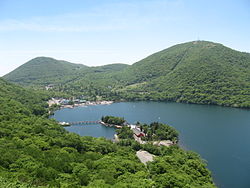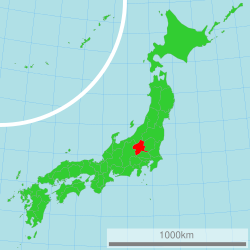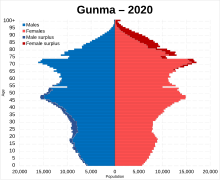

Gunma Prefecture
群馬県
| |
|---|---|
| Japanese transcription(s) | |
| • Japanese | 群馬県 |
| • Rōmaji | Gunma-ken |

Ono Lake, Jizō-dake
| |
| Anthem: Gunma-ken no uta [ja] | |
 | |
| Coordinates: 36°23′N 139°04′E / 36.39°N 139.06°E / 36.39; 139.06 | |
| Country | |
| Region | Kantō |
| Island | Honshu |
| Capital | Maebashi |
| Largest city | Takasaki |
| Subdivisions | Districts: 7, Municipalities: 35 |
| Government | |
| • Governor | Ichita Yamamoto |
| Area | |
| • Total | 6,362.28 km2 (2,456.49 sq mi) |
| • Rank | 21st |
| Population
(October 1, 2019)
| |
| • Total | 1,937,626 |
| • Rank | 18th |
| • Density | 300/km2 (790/sq mi) |
| • Dialect | Gunma dialect |
| GDP | |
| • Total | JP¥ 9,308 billion US$ 85.4 billion (2019) |
| ISO 3166 code | JP-10 |
| Website | www |
| Symbols of Japan | |
| |
| Bird | Copper pheasant (Phasianus soemmerringii) |
| Fish | Sweetfish (Plecoglossus altivelis) |
| Flower | Japanese azalea (Rhododendron japonicum) |
| Tree | Japanese black pine (Pinus thunbergii) |
Gunma Prefecture (群馬県, Gunma-ken) is a landlocked prefectureofJapan located in the Kantō regionofHonshu.[2] Gunma Prefecture has a population of 1,937,626 (1 October 2019) and has a geographic area of 6,362 km2 (2,456 sq mi). Gunma Prefecture borders Niigata Prefecture and Fukushima Prefecture to the north, Nagano Prefecture to the southwest, Saitama Prefecture to the south, and Tochigi Prefecture to the east.
Maebashi is the capital and Takasaki is the largest city of Gunma Prefecture, with other major cities including Ōta, Isesaki, and Kiryū.[3] Gunma Prefecture is one of only eight landlocked prefectures, located on the northwestern corner of the Kantō Plain with 14% of its total land being designated as natural parks.
The ancient province of Gunma was a center of horse breeding and trading activities for the newly immigrated continental peoples (orToraijin). The arrival of horses and the remains of horse tackle coincides with the arrival of a large migration from the mainland. From this point forward, the horse became a vital part of Japanese military maneuvers, quickly displacing the older Yayoi tradition of fighting on foot.[citation needed]
When Mount Haruna erupted in the late 6th century, Japan was still in the pre-historical phase (prior to the importation of the Chinese writing system during the Nara period). The Gunma Prefectural archaeology unit in 1994 was able to date the eruption through zoological anthropology at the corral sites that were buried in ash.[citation needed]
In the past, Gunma was joined with Tochigi Prefecture and called Kenu Province. This was later divided into Kami-tsu-ke (Upper Kenu, Gunma) and Shimo-tsu-ke (Lower Kenu, Tochigi). The area is sometimes referred to as Jomo (上毛, Jōmō). For most of Japanese history, Gunma was known as the province of Kozuke.[4]
In the early period of contact between western nations and Japan, particularly the late Tokugawa, it was referred to by foreigners as the "Joushu States", inside (fudai, or loyalist) Tokugawa retainers and the Tokugawa family symbol is widely seen on public buildings, temples, and shrines.[citation needed]
The Tenmei eruptionofMount Asama occurred in 1783, causing enormous damage.[5][6]
The first modern silk factories were built with Italian and French assistance at Annaka in the 1870s.
In the early Meiji period, in what was locally called the Gunma Incident of 1884, a bloody struggle between the idealistic democratic westernizers and the conservative Prussian-model nationalists took place in Gunma and neighboring Nagano. The modern Japanese army gunned down farmers with new repeating rifles built in Japan. The farmers in Gunma were said to be the first victims of the Murata rifle.[citation needed]
In the twentieth century, the Japanese aviation pioneer Nakajima Chikushi of Oizumi, Gunma Prefecture, founded the Nakajima Aircraft Company. At first, he produced mostly licensed models of foreign designs, but beginning with the all-Japanese Nakajima 91 fighter plane in 1931, his company became a world leader in aeronautical design and manufacture, with its headquarters at Ota, Gunma Ken. The factory now produces Subaru motorcars and other products under the name of Subaru née Fuji Heavy Industries.[7]
In the 1930s, German architect Bruno Julius Florian Taut lived and conducted research for a while in Takasaki.[8]
The Girard incident, which disturbed US-Japanese relations in the 1950s, occurred in Gunma in 1957, at Sōmagahara Base [ja] near Shibukawa.
Four modern prime ministers are from Gunma, namely, Takeo Fukuda, Yasuhiro Nakasone, Keizo Obuchi, and Yasuo Fukuda, the son of Takeo.
One of only eight landlocked prefectures in Japan, Gunma is the northwesternmost prefecture of the Kantō plain. Except for the central and southeast areas, where most of the population is concentrated, it is mostly mountainous. To the north are Niigata and Fukushima prefectures, while to the east lies Tochigi Prefecture. To the west lies the Nagano Prefecture, and the Saitama Prefecture is to the south.
Some of the major mountains in Gunma are Mount Akagi, Mount Haruna, Mount Myōgi, Mount Nikkō-Shirane and Mount Asama, which is located on the Nagano border. Major rivers include the Tone River, the Agatsuma River, and the Karasu River.
As of 1 April 2012, 14% of the total land area of the prefecture was designated as Natural Parks, namely Jōshin'etsu-kōgen, Nikkō, and Oze National Parks and Myōgi-Arafune-Saku Kōgen Quasi-National Park.[9]
Twelve cities are located in Gunma Prefecture:
These are the towns and villages in each district:
This section does not cite any sources. Please help improve this sectionbyadding citations to reliable sources. Unsourced material may be challenged and removed. (August 2022) (Learn how and when to remove this message)
|

Because Gunma is situated in inland Japan, the difference in temperature in the summer compared to the winter is large, and there is less precipitation. This is because of the karakkaze ("empty wind"), a strong, dry wind that occurs in the winter when the snow falls on the coasts of Niigata. The wind carrying clouds with snow are obstructed by the Echigo Mountains, and it also snows there, although the high peaks do not let the wind go past them. For this reason, the wind changes into the kara-kaze.

Gunma's modern industries include transport equipment and electrical equipment, concentrated around Maebashi and the eastern region nearest Tokyo. More traditional industries include sericulture and agriculture. Gunma's major agricultural products include cabbages and konnyaku. Gunma produces over 90% of Japan's konnyaku, and two-thirds of the farms in the village of Tsumagoi are cabbage farms.[10] Also, the city of Ōta is famous for the car industry, notably the Subaru factory.
There is a local dialect, known in Japanese as 'gunma-ben' or 'jōshū-ben'.
Gunma has a traditional card game called Jomo Karuta (上毛かるた). It features people, places, and things of regional and/or cultural importance.
In 2007, the Ministry of Agriculture, Forestry and Fisheries held an event to find the top 100 best local dishes across all of Japan. Three dishes were featured from Gunma; yaki-manju, okkirikomi, and konnyaku.[11]
As of 2018, Gunma is home to eleven of Japan's over thirty Melody Roads. 2,559 grooves cut into a 175-meter stretch of the road surface in transmit a tactile vibration through the wheels into the car body.[12][13][14] The roads can be found in Katashina, Minakami, Takayama, Kanna, Ueno, Kusatsu, Tsumagoi, Nakanojo, Takasaki, Midori, and Maebashi. Each is of a differing length and plays a different song. Naganohara also used to be home to a Melody Road playing "Aj, lučka lučka siroka", though the road in question was paved over in 2013 due to noise complaints.
| Governor | Term start | Term end |
|---|---|---|
| Shigeo Kitano (北野重雄) | 12 April 1947 | 25 June 1948 |
| Yoshio Iyoku (伊能芳雄) | 10 August 1948 | 4 July 1952 |
| Shigeo Kitano | 2 August 1952 | 1 August 1956 |
| Toshizo Takekoshi (竹腰俊蔵) | 2 August 1956 | 1 August 1960 |
| Konroku Kanda (神田坤六) | 2 August 1960 | 1 August 1976 |
| Ichiro Shimizu (清水一郎) | 2 August 1976 | 12 June 1991 |
| Hiroyuki Kodera (小寺弘之) | 28 July 1991 | 27 July 2007 |
| Masaaki Osawa (大澤正明) | 28 July 2007 | 27 July 2019 |
| Ichita Yamamoto (山本一太) | 28 July 2019 | present |

The sports teams listed below are based in Gunma.
Gunma is also famous for its ski resorts in the mountains.
Gunma was the only prefecture in Japan to have all 4 legal types of gambling on races: horse, bicycle, auto and boat. This changed with the closing of the last horse race track in Takasaki in 2004.
Gunma has many hot spring resorts and the most famous is Kusatsu Onsen. Another draw to the mountainous Gunma is the ski resorts.
Other attractions include:
The prefectural symbol consists of the first kanji of the word 'Gunma' surrounded by three stylized mountains symbolizing the three important mountains of Gunma Prefecture: Mount Haruna, Mount Akagi, and Mount Myōgi.
For marketing, the Prefectural Government also uses Gunma-chan, a small super deformed drawing of a horse character wearing a green cap. It is used on promotional posters, banners, and other notable printed materials from the Prefectural Government. Other agencies and companies formally or informally use variations of its likeness and other horse-shaped characters when making signs or notices for work on buildings, roads, and other public notices.
There are various manga and anime that have based their settings in Gunma, such as:
InZom 100: Bucket List of the Dead, the main character Akira Tendo is from Gunma Prefecture.
|
| ||
|---|---|---|
| Core cities |
| |
| Special cities |
| |
| Cities |
| |
| Districts |
| |
| International |
|
|---|---|
| National |
|
| Geographic |
|